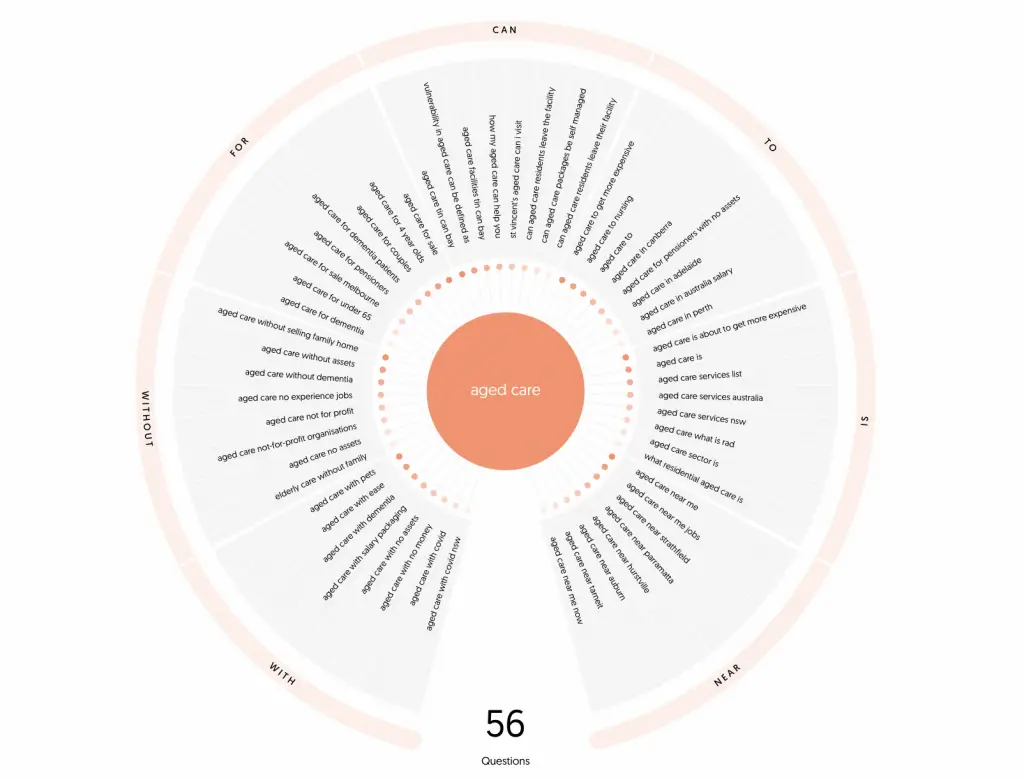Investment and advisory firm Joseph Palmer & Sons have compiled a list of the Top 10 most common questions they hear from clients who are contemplating retirement and/or a future where they or family members require care.
For many, aged care is as much a discussion about finance and large sums of money, with Inside Ageing’s recent Digital Marketing Masterclass highlighting some of the most searched terms to do with the subject. The below visual indicates terms such as ‘Aged Care Without Selling Family Home and Aged Care Without Assets’ as some of the most searched terms on Google in Australia. Video recordings of the masterclass can be purchased here.

The aged care industry is highly complex, and many decisions must be made, often quickly and usually involving large sums of money. Recent changes to the age pension and the Maximum Permissible Interest Rate (MPIR) both affect the cost of aged care.
For instance, the Daily Accommodation Payment (DAP) on a Refundable Accommodation Deposit (RAD, formerly known as a bond) of $750,000 increased on 1 October to $129.65 per day from $102.74 per day (it was $83.63 per day in April).
What people want to know
- What is a Refundable Accommodation Deposit (RAD)?
A: Most new residents in residential aged care negotiate a room price with the aged-care facility before moving in. This is called a Refundable Accommodation Deposit (RAD). You will not be required to pay the RAD if you are eligible for government assistance as a low-means resident.
- Will I need to sell the family home to pay the Refundable Accommodation Deposit (RAD)?
A: This is the most common question we get and the short answer is, not necessarily. The family home is often a couple’s most valuable asset and many advisers wrongly assume that it needs to be sold to provide funds for RADs. The key driver is to make sure that, like any valuable asset, the home generates a financial return. This return takes the form of rental income and capital growth (which RADs certainly don’t provide). The home is treated on a concessional basis for the age pension and aged care fees. For age pension purposes, if you move into care the former home’s value will be excluded from the age pension assets test for 2 years although any rental income will be assessable under the income test. The value of the home is capped at $186,331 for aged care means-testing, and any rental income is assessable.
- Is the RAD negotiable and what alternatives do I have to pay it?
A: RADs can be as high as $2 million to secure a bed in an aged care facility. In many cases these RADs are negotiable, and at times can be as much as halved. Willingness to negotiate on RADs depends very much on the demand for beds – and the supply of beds – in a particular aged care facility. Many aged care facilities prefer the RAD be paid as a lump sum upfront. However, it is possible to choose to pay interest payments (DAPs) only or pay with a combination of lump sum and interest payments. A bank guarantee is not an alternative. The interest rates you pay are set under the Aged Care Act – currently 6.31%. From October 1, on a $1 million RAD, if choosing to pay via a daily payment, you’ll pay $63,000 a year.
- Will my family get all of the RAD back?
A: In a government-accredited aged care facility, the accommodation deposit is fully government guaranteed. Before July 2014, the accommodation bond repaid to the family would be reduced by retention amounts deducted by the aged care facility. Since July 2014, any lump sum paid as a RAD is now fully refundable and generally repaid 14 days after a person leaves the facility or, where the resident has passed away, to their estate when probate has been granted.
“Navigating the complexities of the aged care system is a daunting and arduous task for people, and often done under duress and time pressure. It is very difficult for most people to understand the implications and then come up with the right strategies for the best possible outcome for a loved one.
Rodney Horin, CEO of Joseph Palmer & Sons
- What is the Means Tested Care Fee?
A: The Means Tested Care Fee is set by the government and collected by the aged care facility based on an individual assessment for each resident. It is an attempt by the government to ask residents with the financial capacity to contribute to the cost of care. This fee can range from nothing to a maximum $264 per day, capped at $30,574 per annum or $73,378 over a lifetime (just over two years of payments).
- Why does the Government charge different Means Tested Care Fees to residents?
A: While all residents pay the same Basic Daily Fee ($56.87 per day, or 85% of the full age pension), the Means Tested Care Fee varies from person to person depending on their assets and income.
- Why is the Means Tested Care Fee so high and how do I reduce it?
A: The Means Tested Care Fee is based upon the income and assets of the aged care resident, so it increases as the resident’s assessable assets and income increase. For example, a resident on a full age pension with assets totaling $250,000 and deemed to be earning $4,497 per year will pay $1.75 per day ($638 per year) in aged care, while a resident with assets totalling $1.25 million and deemed to be earning $26,997 per year will pay $51.23 per day ($18,698 per year). One option to reduce the Means Tested Care Fee is to buy an aged care annuity, if appropriate. We recommend financial advice in relation to this product.
- What is the Extra Services Fee and should I pay it?
A: The Extra Services Fee, which can be as much as $120 per day, is supposed to give the resident extra services, including more activities, outings, daily newspapers, more meal choices, pay TV and access to people like podiatrists, hairdressers etc. If your aged care facility is charging an Extra Services Fee, you should ask what services are being delivered and assess whether or not you are receiving value for money. This fee, too, may be negotiated.
- Paying daily fees will impact my cash flow. What strategies are there for dealing with this?
A: It is possible to have some or all of the daily fees deducted from the RAD that has been paid to minimise the impact on your cash flow. This means of course that the DAP will increase over time and less of the RAD will be returned at the end of the care period.
- What implications are there for my social security or pension?
A: The RAD is an excluded asset for social security purposes. Therefore, in some cases, where existing cash is used to pay for a RAD, it can result in a new or increased pension entitlement. More often, a family home is sold to fund the RAD. In this case, while the home is excluded, the proceeds from its sale are counted as an asset. As a result, the cash remaining after paying the RAD can often result in a pension being reduced or lost entirely. However, there are ways to maintain, or even increase, one’s current entitlements.










